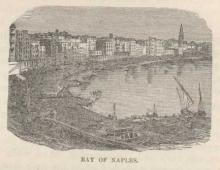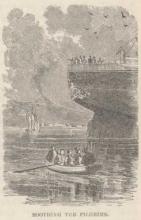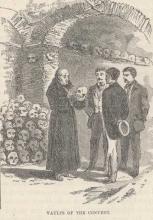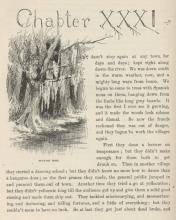The Innocents Abroad - Chapter 30
- Read more about The Innocents Abroad - Chapter 30
- 1 comment
- Log in to post comments
Mark Twain finds fault with the Neapolitan people but appreciates Naples from a distance, from the side of Mt Vesuvius.

Mark Twain finds fault with the Neapolitan people but appreciates Naples from a distance, from the side of Mt Vesuvius.

Mark Twain and a few other of the Pilgrims had decided not to sail to Naples aboard the Quaker City as they knew it would be put in quarantine there. They took the train from Rome. While the quarantine existed they enjoyed teasing those stuck aboard. Along with this amusement they frolicked on the island of Ischia, climbed Mt Vesuvius and visited the opera. In this chapter he is quite critical of the peoples of Naples and of a town he calls Annunciation, at the foot of Mt Vesuvius, although I can find no reference to this town.

The pilgrims visit the rather macabre Capuchin Crypt, wherein the bones of deceased monks of the order are used as a sort of sculptures. It is said they are not meant tio be macabre but as " a silent reminder of the swift passage of life on Earth.". Twain also remarks that there are few art works of historical events in Rome, except for the Rape of the Sabines. This is my second attempt to use Blip.tv as a platform for serving the video slide shows. It should be automatically linked to a YouTube version as well.

I've switched to a new video service, blip.tv. It's my hope that it will provide a wider promotion field for these videos. This particular chapter contains a story from Twain's Roughing It days about a young lawyer named Oliver. We also learn of the strategy employed by our pilgrims in dealing with tour guides, also known as the Fergusons.

Huck can't seem to shake the king and the duke and soon discovers the king has sold Jim to a farmer . He must decide what to do about it. Should he write back to Miss Watson, Jim's owner, or try and steal him back again.

This is a particularly long chapter covering several interesting topics. Twain begins by discussing the phenomena of discovery, giving several examples throughout history, and saying it confers the greatest of pleasures. He then provides a portrait of America through the ideas of an invented modern Roman. Twain then takes us on a visit to St Peters Cathedral. He is nearly over whelmed by it's size. He follows this with a discussion of the difference between Roman "barbarians" who threw Christians to the lions versus the enlightened Christians and their Inquisition.
